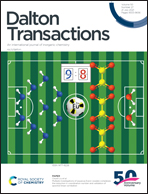Identifying the preferential pathways of CO2 capture and hydrogenation to methanol over an Mn(i)–PNP catalyst: a computational study†
Abstract
CO2 hydrogenation to CH3OH is a crucial conversion for several purposes. Density functional theory (DFT) studies have been performed to explore the mechanistic pathways of newly reported CO2 capture and hydrogenation to methanol. The present study describes the multistep transformation of CO2 to methanol. In this case we have introduced 2-amino-1-propanol to capture CO2 and hydrogenation of the CO2 captured product (oxazolidinone) in the presence of an active Mn(I)–PNP based catalyst. All the plausible pathways for oxazolidinone hydrogenation to methanol have been explored in detail. Here, hydride and proton transfer steps are very important for oxazolidinone hydrogenation, whereas heterolytic H2 cleavage is the most important step for the regeneration of the catalyst. Our detailed study shows that C–N bond hydrogenation followed by C–O and C![[double bond, length as m-dash]](https://www.rsc.org/images/entities/char_e001.gif) O bond hydrogenations or C–O bond hydrogenation followed by C–N and C
O bond hydrogenations or C–O bond hydrogenation followed by C–N and C![[double bond, length as m-dash]](https://www.rsc.org/images/entities/char_e001.gif) O bond hydrogenations are the most favourable pathways for oxazolidinone hydrogenation to methanol with a total reaction free energy barrier of 36.9 kcal mol−1 for both the pathways in the presence of a Mn(I)–PNP catalyst.
O bond hydrogenations are the most favourable pathways for oxazolidinone hydrogenation to methanol with a total reaction free energy barrier of 36.9 kcal mol−1 for both the pathways in the presence of a Mn(I)–PNP catalyst.



 Please wait while we load your content...
Please wait while we load your content...